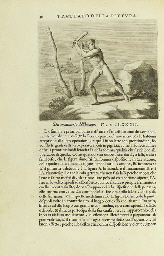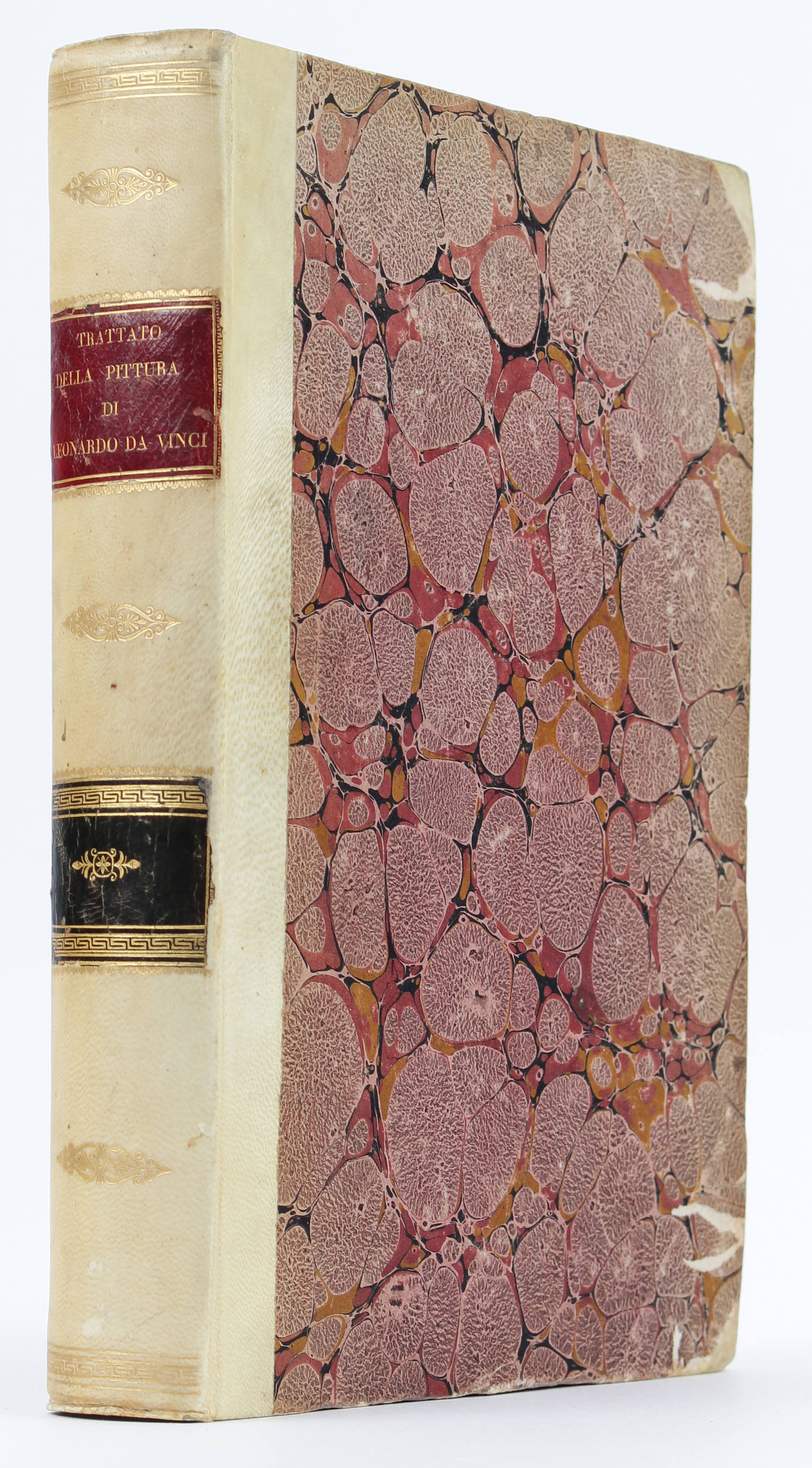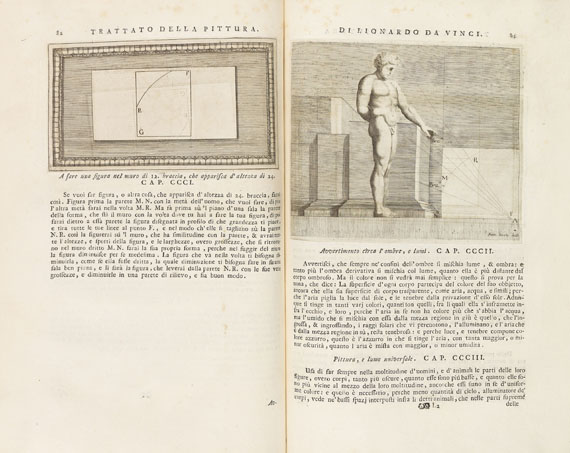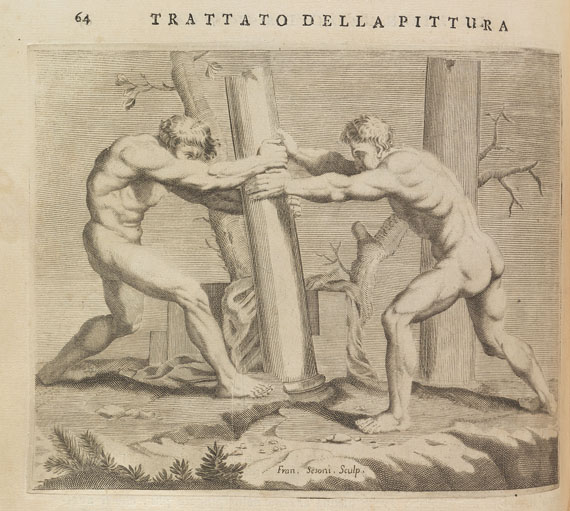Leonardo da Vinci "Trattato della Pittura." Manuscript on paper. Rome: workshop of Cassiano dal Pozzo, ca. 1638–1641
This unusually clean copy of the manuscript was made in the atelier of Cassiano dal Pozzo, secretary to Cardinal Francesco Barberini, the nephew of Pope Urban VIII. It bears a watermark of commercialized paper from Foligno that Dal Pozzo often used, and the ink and binding match other manuscripts prepared in his atelier during the late 1630s.
Leonardo's Treatise on Painting was compiled by Francesco Melzi, a Milanese nobleman who studied painting with Leonardo and became his lifelong companion, based upon eighteen autograph manuscripts. Melzi read through these volumes, marked the passages related to painting, grouped them into categories, and copied the passages and related drawings in a codex now in the Vatican Library. Before his death in 1567, at least two editors and a censor looked over the volume; a decision was reached to shorten the text and remove potentially heretical passages. This abridgement forms the basis for the text.
Dal Pozzo owned more than one early copy of the abridged treatise, which he edited for publication. He commissioned new drawings to be engraved for a lavish volume: Nicolas Poussin (Les Andelys 1594–Rome 1665) for the figures in motion and Gaspare Berti (1601–1643) for the scientific diagrams. Their originals are in the heavily edited copy in the Ambrosiana Library in Milan that formerly belonged to Dal Pozzo. When the Fréart brothers came to Rome in 1640 on the order of King Louis XIII to bring Poussin to Paris, Dal Pozzo gave them two clean copies of that edited manuscript: the copy that went to Paul Fréart de Chantelou, now in the Hermitage, has been much studied; this copy, that went to Roland Fréart de Chambray, was unknown to scholars before 2018 when notice of its existence and its provenance appeared in Farago, Bell, and Vecce, The Fabrication of Leonardo da Vinci’s Trattato della pittura (Leiden, 2018).
Although Chambray prepared the French translation that appeared in the same year as the Italian edition, he did not mark up this copy, as a result of which it is remarkably well preserved. (On the unresolved question of whether Fréart de Chambray consulted this manuscript, see “The final text” in The Fabrication, pp. 300–369 (pp. 300–324). The drawings are copies of the originals and by a draftsman of less talent than Poussin, but they closely follow the proportions and shading of his originals, perhaps due to having been traced. One of its principal features is that none of the illustrations are missing. As a result, it is the only surviving copy from the Dal Pozzo workshop of Berti's original landscape illustration to Chapter 166 "On Aerial Perspective." The illustration that appears in the printed editions was designed by Charles Errard, chief designer and supervisor of the engravings.
Another important feature is that it incorporates the corrections made in the margins and above the lines in the Hermitage manuscript. It may also have been used to determine the placement of the illustrations, since the published editions follow their placement in this copy where it differs from the Hermitage and Ambrosian Library copies.
Sotheby's is very grateful to Janis Bell for providing the above essay, as well as for her description of the contents of the manuscript.
Folio (312 x 213 mm). 102 unnumbered leaves (including 7 blanks) of the abridged version of Melzi’s Libro di pittura (vu: Urbinas), without title-page or pagination. The paper bears watermarks common to manuscripts produced in the Dal Pozzo workshop: (1) a bird on a three-tiered mound, and (2) a bird on a single mound with A N on either side; the space between the chain-lines is 29 mm for both the endleaves and the text block.
The volume begins with a copy of Vasari’s “Vita di Lionardo,” ff. 1–9, followed by two blank sheets. The Trattato begins with the Indice of numbered chapter headings, ff. 11–18r, followed by one blank sheet, then the chapters with headings, ff. 20–98. This is followed by a sheet with a note in French, “second Partie du Manuscrit de Leonard de Vinci,” the verso of which is blank, preceding a compilation of texts on perspective, light and shadow, human movement, proportions, and landscape elements, grouped in sections A through O, that were transcribed from Leonardo’s autograph manuscripts by Milanese members of Dal Pozzo’s editorial project. These extra chapters are also found in m2: H227, m4: H229, l2: Belt 36, b2: Brooker 2, and n1: Corazza, a miscellaneae in Naples. At the end is a copy of the note from the Milanese transcriber beginning “Delle figure ricercate … ” and ending “all’ Alfabeto segnato nella stessa gionta,” followed by two blank sheets.
The main body of the treatise is divided into 375 chapters illustrated by 56 drawings in ink tipped into the manuscript in a manner similar to m3: H228, which contains Poussin’s original drawings (those in b1 are tracings, with added wash). The second part (the “added chapters”) contains 26 drawings copied from m4: H229.
binding: Seventeenth-century Italian vellum over pasteboards (319 x 214 mm), the spine numbered in ink 158, traces of 2 pairs of ties, plain pastedowns (no free endpapers), plain edges. (Lightly stained, 110 x 50 mm piece of vellum lost from upper fore-edge corner of rear cover.
Please note: The binding is almost identical to the bindings of other Dal Pozzo manuscripts, including Cassiano’s personal copy (MS H228 at Biblioteca Ambrosiana).
provenance: The manuscript prepared in Cassiano Dal Pozzo’s atelier — “158” written in ink on spine (unidentified) — possibly Joachim von Sandrart (1606–1688) — possibly Roland Fréart, sieur de Chambray (1606–1676) — Antoine Callet (1755–1850?), by descent to — his architect-sonc, Félix-Emmanuel Callet (1791–1854; Pouchet et Pigeau, Paris, Catalogue d’objets d’art, antiquités … tableaux, dessins, gravures, livres à figures sur les antiquités, l’architecture et les beaux-arts, manuscrits qui composent le cabinet et la bibliothèque de feu M. Callet, Architecte du Gouvernement. Deuxième partie, 26 February–5 March 1855, lot 123 (“Ce manuscrit a été acquis par M. Callet père, d’un descendants de M. Freart de Chambray”), purchased by — unidentified owner (FF 200; clipping from 1855 sale catalogue pasted to inside front cover). acquisition: Purchased from Librairie Paul Jammes, Paris, 1990.
references: Claire Farago, Janis Bell, and Carlo Vecce, The Fabrication of Leonardo da Vinci’s Trattato della pittura (Leiden, 2018), “Appendix A — Brooker 1,” pp. 1127–1128 (this manuscript designated b1), & passim.
Leonardo da Vinci "Trattato della Pittura." Manuscript on paper. Rome: workshop of Cassiano dal Pozzo, ca. 1638–1641
This unusually clean copy of the manuscript was made in the atelier of Cassiano dal Pozzo, secretary to Cardinal Francesco Barberini, the nephew of Pope Urban VIII. It bears a watermark of commercialized paper from Foligno that Dal Pozzo often used, and the ink and binding match other manuscripts prepared in his atelier during the late 1630s.
Leonardo's Treatise on Painting was compiled by Francesco Melzi, a Milanese nobleman who studied painting with Leonardo and became his lifelong companion, based upon eighteen autograph manuscripts. Melzi read through these volumes, marked the passages related to painting, grouped them into categories, and copied the passages and related drawings in a codex now in the Vatican Library. Before his death in 1567, at least two editors and a censor looked over the volume; a decision was reached to shorten the text and remove potentially heretical passages. This abridgement forms the basis for the text.
Dal Pozzo owned more than one early copy of the abridged treatise, which he edited for publication. He commissioned new drawings to be engraved for a lavish volume: Nicolas Poussin (Les Andelys 1594–Rome 1665) for the figures in motion and Gaspare Berti (1601–1643) for the scientific diagrams. Their originals are in the heavily edited copy in the Ambrosiana Library in Milan that formerly belonged to Dal Pozzo. When the Fréart brothers came to Rome in 1640 on the order of King Louis XIII to bring Poussin to Paris, Dal Pozzo gave them two clean copies of that edited manuscript: the copy that went to Paul Fréart de Chantelou, now in the Hermitage, has been much studied; this copy, that went to Roland Fréart de Chambray, was unknown to scholars before 2018 when notice of its existence and its provenance appeared in Farago, Bell, and Vecce, The Fabrication of Leonardo da Vinci’s Trattato della pittura (Leiden, 2018).
Although Chambray prepared the French translation that appeared in the same year as the Italian edition, he did not mark up this copy, as a result of which it is remarkably well preserved. (On the unresolved question of whether Fréart de Chambray consulted this manuscript, see “The final text” in The Fabrication, pp. 300–369 (pp. 300–324). The drawings are copies of the originals and by a draftsman of less talent than Poussin, but they closely follow the proportions and shading of his originals, perhaps due to having been traced. One of its principal features is that none of the illustrations are missing. As a result, it is the only surviving copy from the Dal Pozzo workshop of Berti's original landscape illustration to Chapter 166 "On Aerial Perspective." The illustration that appears in the printed editions was designed by Charles Errard, chief designer and supervisor of the engravings.
Another important feature is that it incorporates the corrections made in the margins and above the lines in the Hermitage manuscript. It may also have been used to determine the placement of the illustrations, since the published editions follow their placement in this copy where it differs from the Hermitage and Ambrosian Library copies.
Sotheby's is very grateful to Janis Bell for providing the above essay, as well as for her description of the contents of the manuscript.
Folio (312 x 213 mm). 102 unnumbered leaves (including 7 blanks) of the abridged version of Melzi’s Libro di pittura (vu: Urbinas), without title-page or pagination. The paper bears watermarks common to manuscripts produced in the Dal Pozzo workshop: (1) a bird on a three-tiered mound, and (2) a bird on a single mound with A N on either side; the space between the chain-lines is 29 mm for both the endleaves and the text block.
The volume begins with a copy of Vasari’s “Vita di Lionardo,” ff. 1–9, followed by two blank sheets. The Trattato begins with the Indice of numbered chapter headings, ff. 11–18r, followed by one blank sheet, then the chapters with headings, ff. 20–98. This is followed by a sheet with a note in French, “second Partie du Manuscrit de Leonard de Vinci,” the verso of which is blank, preceding a compilation of texts on perspective, light and shadow, human movement, proportions, and landscape elements, grouped in sections A through O, that were transcribed from Leonardo’s autograph manuscripts by Milanese members of Dal Pozzo’s editorial project. These extra chapters are also found in m2: H227, m4: H229, l2: Belt 36, b2: Brooker 2, and n1: Corazza, a miscellaneae in Naples. At the end is a copy of the note from the Milanese transcriber beginning “Delle figure ricercate … ” and ending “all’ Alfabeto segnato nella stessa gionta,” followed by two blank sheets.
The main body of the treatise is divided into 375 chapters illustrated by 56 drawings in ink tipped into the manuscript in a manner similar to m3: H228, which contains Poussin’s original drawings (those in b1 are tracings, with added wash). The second part (the “added chapters”) contains 26 drawings copied from m4: H229.
binding: Seventeenth-century Italian vellum over pasteboards (319 x 214 mm), the spine numbered in ink 158, traces of 2 pairs of ties, plain pastedowns (no free endpapers), plain edges. (Lightly stained, 110 x 50 mm piece of vellum lost from upper fore-edge corner of rear cover.
Please note: The binding is almost identical to the bindings of other Dal Pozzo manuscripts, including Cassiano’s personal copy (MS H228 at Biblioteca Ambrosiana).
provenance: The manuscript prepared in Cassiano Dal Pozzo’s atelier — “158” written in ink on spine (unidentified) — possibly Joachim von Sandrart (1606–1688) — possibly Roland Fréart, sieur de Chambray (1606–1676) — Antoine Callet (1755–1850?), by descent to — his architect-sonc, Félix-Emmanuel Callet (1791–1854; Pouchet et Pigeau, Paris, Catalogue d’objets d’art, antiquités … tableaux, dessins, gravures, livres à figures sur les antiquités, l’architecture et les beaux-arts, manuscrits qui composent le cabinet et la bibliothèque de feu M. Callet, Architecte du Gouvernement. Deuxième partie, 26 February–5 March 1855, lot 123 (“Ce manuscrit a été acquis par M. Callet père, d’un descendants de M. Freart de Chambray”), purchased by — unidentified owner (FF 200; clipping from 1855 sale catalogue pasted to inside front cover). acquisition: Purchased from Librairie Paul Jammes, Paris, 1990.
references: Claire Farago, Janis Bell, and Carlo Vecce, The Fabrication of Leonardo da Vinci’s Trattato della pittura (Leiden, 2018), “Appendix A — Brooker 1,” pp. 1127–1128 (this manuscript designated b1), & passim.














Testen Sie LotSearch und seine Premium-Features 7 Tage - ohne Kosten!
Lassen Sie sich automatisch über neue Objekte in kommenden Auktionen benachrichtigen.
Suchauftrag anlegen